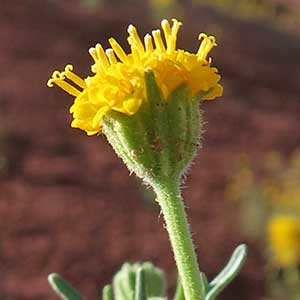Chaenactis douglasii
Chaenactis nevii
chaenactis, Douglas' dusty maidens, Douglas' dustymaiden, hoary chaenactis, hoary false-yarrow, hoary pincushion
John Day pincushion, John Day's pincushion, Nevius' chaenactis
1–25+, erect to spreading.
mostly 1–3;
branches mainly distal.
basal, or basal (sometimes withering) and ± cauline, (1–)2–12(–15) cm;
largest blades ± elliptic or slightly lanceolate to ovate, ± 3-dimensional, usually 2-pinnately lobed;
primary lobes (4–)5–9(–12) pairs, ± congested, scarcely imbricate, ultimate lobes ± involute and/or twisted.
basal (withering) and cauline, 2–5 cm;
largest blades ± elliptic, ± plane to 3-dimensional, not succulent, 1–2-pinnately lobed;
primary lobes mostly 3–8 pairs, ± remote, ultimate lobes ± plane to involute.
mostly ascending to erect, 1–10 cm.
1–6 cm, distally stipitate-glandular and, sometimes, ± arachnoid to villous.
obconic to ± hemispheric.
± hemispheric to campanulate.
corollas bright yellow, 4–6.5 mm;
peripheral corollas ± erect, actinomorphic, scarcely enlarged.
5–8 mm.
longest 9–15(–17) mm;
outer usually stipitate-glandular (sometimes sparsely or obscurely, rarely eglandular) and, often, arachnoid to lanuginose and, sometimes, sparsely villous, apices usually ± squarrose, pliant.
longest 6–9 mm;
outer predominantly stipitate-glandular and, sometimes, ± arachnoid to villous in fruit, apices ± erect, acute, rigid.
1–25+ per stem.
mostly 3–9 per stem.
5–8 mm (usually sparsely glandular amidst other indument);
pappi: longest scales 3–6 mm.
3.5–6 mm (compressed);
pappi 0 or coroniform (of ± 10 scales, longest 0.1–0.5 mm).
= 12.
Chaenactis douglasii
Chaenactis nevii
Varieties 2 (2 in the flora).
Chaenactis douglasii is widespread and variable (see discussion under var. douglasii).
(Discussion copyrighted by Flora of North America; reprinted with permission.)
Chaenactis nevii is known from the John Day Basin area in Gilliam, Grant, Jefferson, Wasco, and Wheeler counties. This odd and isolated species combines traits of C. artemisiifolia (sect. Acarphaea) and C. glabriuscula, and might be descended from their common ancestor.
(Discussion copyrighted by Flora of North America; reprinted with permission.)
1. Leaves basal (sometimes withering) and ± cauline; plants not or scarcely cespitose, not matted; stems usually 1–5(–12); heads (1–)2–25+ per stem | var. douglasii |
1. Leaves strictly basal; plants cespitose or ± matted; stems (1–)10–25+; heads 1(–2) per stem | var. alpina |
- Local floras:
BC,
CA,
OR,
WA
- Local Web sites:
CalFlora,
CalPhotos,
Flora NW,
PNW Herbaria,
Turner Photog.
WildflowerSearch
iNaturalist (observations)
USDA Plants Database
- LBJ Wildflower Center
- SEINet
- Plants of the World Online
- Encyclopedia of Life
- Wikipedia
- Google Image Search


